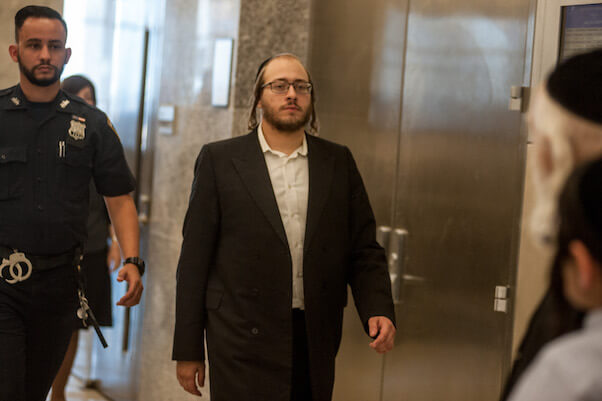Taj Patterson, after suffering an assault by a gang of men in Williamsburg in December 2013.
BY DUNCAN OSBORNE | In its closing statement in the trial of a man charged in a brutal gang assault in Williamsburg that left a gay black man blind in one eye, the defense argued that no witness had identified Mayer Herskovic as the assailant and that the DNA evidence implicating him was based on bad science.
“There is no evidence in this case that puts Mayer Herskovic there,” said Israel Fried, Herskovic’s attorney, in Brooklyn Supreme Court on September 20. “What does this case come down to? It comes down to 97.9 picograms.”
Herskovic is charged with multiple counts of unlawful imprisonment, assault, gang assault, and menacing in the early morning December 1, 2013 attack on Taj Patterson. No witness identified Herskovic as the man who punched Patterson, jammed his thumb in the 25-year-old’s eye, knocked him to the ground, and kicked him in the face.
In non-jury trial, judge could rule as early as Friday
Patterson testified that the man who did those things also pulled off his sneaker and tossed it onto a nearby roof. Police found the sneaker. Using high sensitivity DNA testing, the city medical examiner’s office found Herskovic’s DNA on the sneaker.
Given the evidence, the defense was forced to challenge Patterson’s memory saying he was too drunk to recall the events of that night, and Fried also had to challenge the reliability of high sensitivity DNA testing.
That type of testing uses DNA samples that are measured in picograms, or trillionths of a gram. The medical examiner uses the method to test samples that are less than 100 picograms, which is not recommended by DNA test kit manufacturers. While many labs do this testing, the city medical examiner has the only US lab that uses this method to produce evidence in criminal trials.
The DNA is amplified, or has copies of it reproduced, and then compared to known DNA samples, in this case those of Herskovic and Patterson. The medical examiner’s office uses its own proprietary software, called the Forensic Statistical Tool, to perform an analysis and offer an opinion on how likely it is that a particular individual contributed DNA to a sample.
Fried said the amplification process in high sensitivity DNA testing requires more cycles of reproduction and that creates “a greater likelihood of false positives.” He also said that the DNA evidence showed that there were unidentified alleles, which are a component of DNA, in the sample suggesting that a third person contributed to it. One defense theory is that another individual touched Herskovic and then touched the sneaker. This so-called secondary transfer of DNA is possible.
“All they can say is there is a likelihood that it is his,” Fried said of the DNA. “He’s not there because he’s not in the video and not one witness sees him there.”
A problem for the defense is that Herskovic opted for a non-jury trial. Judge Danny Chun heard the evidence and he could return a verdict the afternoon of September 23 after the prosecution gives its closing statement.
While juries can be swayed by attorneys casting doubt on a witness’ memory and on some science, Chun has been very comfortable with the DNA evidence throughout the trial. He also raised doubts about the defense theory that Patterson was drunk and was hit by someone other than Herskovic only after he started fighting with others.
Fried played three of the videos introduced during the trial that showed Patterson running from three men on Flushing Avenue. He was stopped by a mob of men, many of whom were in a community patrol organized by the Satmar sect of Hasidic Jews in the Brooklyn neighborhood. Fried said Patterson punched one of the men and was then punched.
“He runs away from three people, but when he is surrounded by a bunch of people, he attacks them?” Chun asked Fried in the middle of his summation. Commenting moments later on another video, Chun said, “The complainant is walking straight, he’s not falling down drunk… And you said the video does not lie.”
Troy Holder, a criminalist in the medical examiner’s office who initially testified about the DNA evidence on August 30, and Dr. Craig O’Connor, who supervises the high sensitivity DNA testing lab, attended the closing statement. They grinned at some of Fried’s comments on the DNA evidence and scowled at others. O’Connor testified on September 20 as a rebuttal witness for the prosecution after Fried presented his own DNA expert.
The city medical examiner’s office is part of the city health department. Staff there sees themselves as scientists, and not part of law enforcement, and they will meet with defense attorneys to discuss their findings. Defense attorneys often see the medical examiner’s office as little more than an adjunct to law enforcement.
During the trial, Chun’s small courtroom has typically been crowded with Hasidic men and one or two women who are there to support Herskovic. Patterson’s family and his attorney have been attending, as well. On September 20, the courtroom was so crowded that journalists and staff from the Brooklyn district attorney’s office were moved into the empty jury box. Eric Sanchez, the detective in the NYPD’s Hate Crimes Task Force who led the investigation, also came for closing arguments.





























